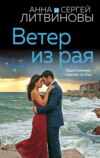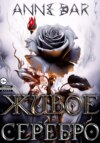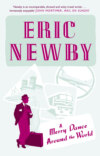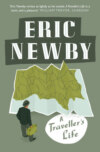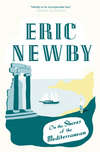Kitabı oku: «Departures and Arrivals»

ERIC NEWBY
Departures and Arrivals

Dedication
To Wanda with love
Many thanks to Lucinda McNeile and Kate Morris for all their help
Contents
Cover
Title Page
Dedication
Introduction
Up to Ther Bend and Back
Travels with a Baby
Days and Nights on the Orient Express
Under the Crust of Coober Pedy
Walking the Plank
Follies and Grottoes
Journey through Syria
The Palio
Seeing the World on Two Wheels
Some Canals
The Land of the Camels
The Land of the Elephants
Two Degrees West
In Calabria
Way Out in Anatolia
Winter in Beijing
The Yemen
A Brief Trip to the Pontine Archipelago
Below the Purbeck Hills
Plates
Index
About the Author
Also by the Author
Copyright
About the Publisher
Introduction
Whatever else we remember of our travels, we remember our departures and arrivals. Often they are the most enduring of all our memories of them. In 1963, together with Wanda, my wife, I embarked on the Ganges in an open boat to row from the foothills of the Himalayas to the Indian Ocean. Some 200 metres from our starting point, from which we had been seen off by an old man who dropped sacred sweets on us as provisions for the journey, and some 1,900 kilometres short of our destination in the Bay of Bengal, the boat grounded in some 40 centimetres of water which proved to be the uniform depth of the Ganges at this season at this point, and it took five-and-a-half days to cover the next 56 kilometres, mostly by pushing it.
Nothing in the course of the entire trip, which took three months to accomplish, left such an indelible imprint on our minds as the moment when we discovered that the Ganges was only 40 centimetres deep and that our boat drew 46 centimetres when loaded.
To depart is often more satisfying than to arrive unless you are the first on the scene. Nothing was more deflationary to Scott and his companions than to find that they were the second party to reach the South Pole. Would I have set off at all if I had known what the journey would be like or what I was going to find at my destination are questions I have often asked myself, reminded of the wartime poster which read ‘Don’t waste food! Why did you take it if you weren’t going to eat it?’ To which some wit added a codicil: ‘I didn’t know it was going to taste like this!’
For years explorers attempted to reach Timbuktu, the mysterious city on the edge of the Sahara that, ever since the twelfth century, had been the hub of the North African world, and in which salt had been traded for the seemingly inexhaustible gold of Guinea, a city in which, according to the Muslim traveller Leo Africanus, who visited it in 1526, there were plates and sceptres of solid gold ‘some whereof weigh 1,300 pounds’.
The first-known European to reach Timbuktu and return in one piece was Réné Caillié, a penniless young Frenchman who had been inspired to become an explorer by reading Robinson Crusoe. Too late to see it in its heyday – the trade in gold had more or less come to an end – he reached the fabled city after a terrifyingly dangerous journey on 20 April 1828. ‘I looked around,’ he wrote, ‘and found the sight before me did not answer my expectations of Timbuktu. The city presented, at first view, nothing but a mass of ill-looking houses, built of earth. Nothing was to be seen in all directions but immense plains of quicksand of a yellowish-white colour.’
No one really enjoys arriving anywhere by train. (Nor does anyone in their right mind enjoy departing or arriving by plane, with the possible exception of the pilot whose toy it is.) Will there be any porters? Will there be any trolleys for the luggage if there aren’t? Will there be any taxis? Will they be fitted with meters? These and similar questions that even the most hardened travellers ask themselves as the train comes into the platform all help to contribute to the particular form of angst, the generally non-specific but nonetheless acute form of anxiety described by Cyril Connolly (disguised under the nom de plume Palinurus) in The Unquiet Grave as the Angoisse des Gares, the Agony of the Stations: ‘Bad when we meet someone at the station, much worse when we are seeing them off; not present when departing oneself, but unbearable when arriving …’
The best arrivals are by sea, that is unless your engine has broken down and the Cliffs of Moher are a lee shore. The first sight of a great city from the sea is big medicine, powerful magic, unforgettable, however much of a let-down it may prove to be on closer acquaintance. New York seen from the Hudson in the early morning with the sun roaring up over the East River turning the tall buildings into gigantic Roman candles; Venice as your vessel runs in through the Porto di Lido into St Mark’s Basin with the domes and campaniles liquefying and reconstituting themselves in the mirage; Istanbul as your ship comes up the Marmara and sweeps round Seraglio Point towards the Golden Horn and you see silhouetted against the evening sky the fantastic, improbable, incomparable skyline of Old Stamboul.
It is not only the great cities that have this effect on the arriving traveller. This is how T. E. Lawrence described his first sight of Jidda, the then little port of Mecca, seen from the deck of a passenger ship in the Red Sea while he was on his way to meet the leaders of the Arab Revolt in 1917: ‘When at last we anchored in the outer harbour off the white town, between the blazing sky and its reflection in the mirage which swept and rolled over the wide lagoon, then the heat of Arabia came out like a drawn sword and struck us speechless … There were only lights and shadows, the white and black gaps of streets: in front, the pallid lustre of the haze shimmering upon the inner harbour; behind, the dazzle of league after league of featureless sand running up to an edge of low hills, faintly suggested in the far away mist and heat.’
It is these and similar vistas, whether wild or civilized, that make one want to shout ‘How beautiful the world is!’, that made an elderly lady of my acquaintance, when taken on an outing from her native village in the Po Valley which she had never previously left, cry on arriving on the watershed of the Apennines from which there was an extensive view, ‘Com’è grande il mondo!’ … ‘How big the world is!’ … and insist on being taken home.
Up to Ther Bend and Back
Castelnau Mansions, Barnes, SW13, the block of flats in which I was born, in 1919, on the south side of Hammersmith Bridge, was one of several such blocks built in the 1900s on what had been marshland and open country.
Our flat was on the first floor – Three Ther Mansions, as it was known to the tradesmen who sent their delivery boys out on bicycles from the nearby shops to deliver my mother’s orders. And it had what the estate agents used to describe in the twenties as ‘commanding extensive and splendid views over the Metropolitan Water Board’s Reservoir and Filter Beds’. The filter beds were lovely, full of golden sand that I longed to play with, but was never able to do so as they were fenced in.
Castelnau, the main road which separated our block of flats from the reservoir, was and is the almost dead-straight road which runs from Hammersmith Bridge to the pub called until recently the Red Lion, and, although it is only about a mile long, it appears to be much longer. It was built in 1827, at the same time as the original Hammersmith Suspension Bridge, a beautiful, slender structure designed by William Tierney Clarke. In 1887 it was replaced by another suspension bridge of cast-iron, a rather elephantine structure designed by Sir Joseph Bazalgette, the man who designed the London sewers. (The IRA tried to blow it up in 1939, but was thwarted when a heroic passer-by picked up the bomb and threw it into the river.) The street was named Castelnau after the family seat of the Boileau family, Castelnau de la Gard at Nîmes, the head of the family being a General de Castelnau.
The Boileau family also had a house by the Thames at Mortlake, upstream from Barnes. In fact the family must be still turning in their graves to hear their beautiful street called ‘Castlenore’, and the Boileau Arms, the handsome pub at the bridge end of it, built in 1842, ‘Ther Boiler’.
Castelnau has only one almost imperceptible kink in its entire length, again known to almost everyone as ‘Ther Bend’, which effectively prevents anyone from looking up or down its entire length from either end, except from the top of a bus.
‘We’ll just walk up to Ther Bend and back,’ my mother would suddenly say when I no longer had a nurse and was too old to travel by mail cart – which my nurse pushed while I sat looking ahead with my back to the engine.
And we used to set off for this short walk up Castelnau, something less than half a mile, suitably clad against the elements, which were as unpredictable in Barnes as anywhere else.
Facing our front door on the same landing as ours, which was the only place for me to play when it rained, was Number Four. It was occupied by a friend of my mother’s. A jolly, long-legged dress-buyer at Derry and Toms, the large department store in Kensington High Street. She loved parties.
She was known to me as ‘Auntie Lil’ and she had been installed in Number Four by her friend, to me a rather elderly dentist who had his practice in an elegant little house behind Kensington Church Street. He was known to me as ‘Uncle Max’. I wasn’t as keen on Uncle Max as I was on Auntie Lil, as he was also my dentist and not surprisingly I associated him with pain. But ‘Auntie Lil’ was all right, and she gave me bars of Fry’s Chocolate Cream to munch, which made more visits to Uncle Max inevitable.
On the whole things were not going well at Number Four. Then Uncle Max left Auntie Lil, and I remember a good deal of wailing taking place while she was being comforted by my mother; but she still stayed on at Number Four, and then, some time later, she went away. I missed Auntie Lil, and her Fry’s Chocolate Cream bars.
The descent to the ground floor, where One and Two were to be found, was by a linoleum-covered staircase with shiny wooden banisters, down which I used to slide. In fact I could slide the whole way down the banisters from the topmost floor to the ground floor, if so inclined.
The only other occupants of the flats on the upper floors I knew were a Hindu doctor named Dr Wallah and his Scottish nurse/girlfriend. Dr Wallah bore a striking resemblance to Gandhi in early life (in South Africa), but both were so desperately shy that it was difficult for even a five-year-old to talk to them.
Down on the ground floor Number One The Mansions was occupied by Mr and Mrs Ludovici. She was called Marie, was French and clever. He was partly Italian and known to his friends as Ludo. He was something pretty important in the Goldsmiths and Silversmiths Company in Regent Street, and had dealings with Indian princes. He went to work each day by taxi, dressed in a double-breasted black jacket, striped trousers, starched white collar and cuffs, and he always wore a clove carnation in his buttonhole, supplied by a florist near the Boileau Arms. Neither Mr nor Mrs Ludovici suffered fools, and/or small boys, gladly or ungladly and I wouldn’t have dared call them Uncle Ludo or Auntie Marie for all the tea in China.
Although posher than the Newbys, the Ludovicis, I was pleased to note, had a much poorer view of the reservoir than we did on the first floor of The Mansions, due to a privet hedge in front of their windows having been allowed to grow to an excessive height. In fact they couldn’t see the reservoir at all. Perhaps they were the sort of people who didn’t care for views of reservoirs.
Down here on the ground floor there was a space under the stairs in which my chained-up mail cart had been parked until recently, still awaiting my parents’ decision as to how to dispose of it. Eventually, they bequeathed it to a tramp – what was then known as ‘a gentleman of the road’ – who was on his way to spend the summer in the vicinity of Penzance but had got blown slightly off course. He said it would be invaluable to him for carrying his gear when sleeping rough in the open. At that time the main roads of Britain were full of tramps, many of them ex-soldiers on their way southwards to the sun, or else, in winter, travelling from one workhouse to another. There were even some women tramps, but they were rather more frightening than the men. Our particular tramp was about forty and had been a corporal in a Rifle Regiment. He was smart as tramps go, but when he left us, pushing what was now his mail cart, after having transferred his possessions to it from a sack and after a slice of fruit cake and a nice cup of hot sweet tea, the following day we found some strange, cabbalistic chalk marks on the wall outside the entrance, which I later learned years later was tramps’ language to the effect that the occupants of Number Three were a decent touch; but none ever came to try us out.
Now, down on the ground floor, we pushed open the main door, which had a glittering pair of brass doorknobs on it, polished by Edwards, the Head Porter, an ex-Guardsman. He was the custodian of all the flats which belonged to the London County Freehold and Leasehold Company. He was also in command of a number of lesser staff – some of them ex-soldiers who limped, having been wounded. They performed more menial functions, mostly in connection with dustbins and their contents. Edwards also polished the buttons on his navy blue tailcoat, using a button stick to prevent the polish getting on the material. Fifteen years later, when I joined the Army, in 1939, I also found myself using a button stick.
And now, out in the front garden of The Mansions, where the hedges were too high to see over, we turned left on to Castelnau for the long walk up to Ther Bend. Well, it seemed long when you were only five.
On our right now was Glentham Road, at that time a working-class street which encompassed the only part of Barnes at the Hammersmith Bridge end that boasted a bit of downhill. In it was the Sunlight Laundry, which took in our washing and employed numbers of cheerful, noisy girls from Hammersmith. This was the street, too, in which my parents’ chauffeur, Mr Lewington, lived, and where he kept our car, an open Citroën, in his garage. Beyond it was Fanny Road (now renamed St Hilda’s Road). It was to be years later, long after the war began, and I was abroad, before anyone living in Barnes found anything remotely funny in the name Fanny in association with a road. That was, until the Americans arrived in Britain in 1942/3. They had somewhat different ideas of what a Fanny was and when they saw Fanny inscribed on a street sign, they fell about. Soon, Americans from as far away as Piccadilly Circus began making pilgrimages to Fanny Road, SW13, on the Number 9 bus.
Then we used to go on, my mother and I, past where the shops began; past the butcher’s and Hewett’s Stores, which had dead ducks, and geese and pheasants, partridges and grouse, all hanging outside on hooks, in due season.
And inside, dressed in white, and wearing a straw boater whatever the season, was Mr Hewett who never failed to stop doing whatever he was doing, to doff his boater to my mother, a customer of some importance, as she sailed past with or without me in tow.
And next to Hewett’s there was the chemist’s, which I liked just about as much as Uncle Fitz’s surgery, as it had a wealth of what I called ‘Nasty Things’ on offer. And next to that there was a haberdasher’s full of boxes bursting with mother-of-pearl buttons and knicker elastic – important when large numbers of ladies kept their handkerchiefs somewhere in their knickers; and there were rolls of lace that kept on unrolling.
This very dark, even then very old-fashioned shop, was run by a pair of what at that time were quite young people. They were still operating after the Second World War, by that time incredibly bent and ancient. They hardly ever spoke, except to say how much the bill came to, and transacted their business with all the animation of a slow-motion film of a ritual. I was frightened of them, all dressed in black.
The next roads on our left, opposite Ther Boiler, were Arundel Terrace and Merthyr Terrace, which led away down to more reservoirs and more filter beds – this end of Barnes had more water than land in it. It was also the road that led to the council allotments, one of which Wanda put in for as soon as she came to live in Barnes, the scourge of the pensioners who predicted that everything she planted would come to a sticky end. ‘All that foreign stuff won’t do ’ere,’ they prognosticated when she started planting ‘foreign stuff’ in appreciable quantities – all of which did marvels, much to their disgust.
On the corner of Merthyr Terrace there was a dairy with a plaster of Paris – well, it looked like plaster of Paris – cow in the window, and walls tiled with dairy scenes. Here, on the premises, fresh-faced girls dispensed the beverage and the milkmen delivered it to their customers from churns loaded on to horse-drawn carts.
On the opposite side of the road there was Ther Boiler. Behind it was then, and for years to come, open country. There was a farm – it must have been one of the nearest farms to the centre of London – which employed numbers of women as casual labourers. When lifting potatoes, or whatever, they worked in all weathers short of a downpour, and they wore sacks as aprons and over their shoulders, and men’s caps. They, too, came over the river from Hammersmith, but they were much tougher than the girls at the Sunlight Laundry. And there was the fishmonger’s, and the Post Office and a florist’s and the newsagent.
The last shop on our side of Castelnau was an ironmonger’s, otherwise the Oil Shop. It was painted green and had two massive amphorae over the front of it of the sort that in Mediterranean lands are used to store olive oil, which here were painted a vivid, pillar-box red.
A short distance up towards Ther Bend was the Holy Trinity church, a rather sad, perpendicular construction of 1868, a not altogether auspicious time for building churches.
I never liked it, nor did I like the Church Hall, the scene of an unsuccessful attempt to ‘interfere’ with me by a bun-faced curate when I was a member of the Wolf Cub pack. The interference only amounted to my being bounced up and down on his knee but I didn’t enjoy it, as I felt that I was too old to be bounced up and down on peoples’ knees, and I told my mother and she told my father, and my father told the vicar and the curate was sent away to wherever curates who tried to ‘interfere’ with Wolf Cubs went at that time.
Near the church during the Second World War there had been an air raid shelter which had received a direct hit by a German rocket at a time when it had been filled with local inhabitants.
Here, on the opposite side of Castelnau to the church, were the premises of Boon and Porter, motor-car salesmen. The most memorable feature of Boon and Porter was an enormous advertisement for French Amilcars painted on a brick wall a couple of storeys high. It showed them roaring round a steep bank, driven by what looked like Michelin Men.
As we approached Ther Bend the houses became progressively finer, the best of all beginning at Ther Bend itself. They were semi-detached brick and stucco residences known as Castelnau Villas, built in 1842, the earliest early Victorian, with coach houses to match, and shaded by noble trees. Even to my five-year-old mind the Villas made the Mansions and the Gardens look a bit feeble – the epitome of an elegance that has rarely been repeated.
What my mother and I most enjoyed about going up to Ther Bend was that it was there that two members of the Constabulary operated what were known as ‘Speed Traps’.
These constables were always the same ones. Both had identical bushy moustaches and both were fat and had very red faces. They could have been twins. When they saw with the aid of binoculars a car coming up Castelnau from the direction of Hammersmith Bridge that in their opinion was exceeding the speed limit, which at that time, in the twenties, was only twenty miles an hour, they rushed out of their hiding place behind one of the massive gate posts of Number 122 Castelnau Villas at Ther Bend blowing their whistles and waving a large red flag at the offending motorist. This dramatic event, which we looked forward to witnessing, invariably took place at three o’clock in the afternoon, by which time they had, presumably, digested their ‘dinner’.
On one occasion they flagged down a Rolls-Royce, the sort in which the chauffeur is isolated from the passengers and exposed to the elements.
They, the constables, were happily engaged in taking down the chauffeur’s particulars when a very small, open motor car driven by a very boozy-looking man came round Ther Bend at about sixty miles an hour, roaring with laughter and thumbing his nose at the constables who had no chance of flagging him down, let alone taking down his particulars.
And it was always at this point, at Number 122 that we turned back. Beyond it was terra incognita so far as my mother was concerned.
Later, when I was given a scooter, I was allowed to scoot up the footpath from our flat past Number 122 to Number 54 Castelnau alone. Number 54 was, and still is, an Edwardian house equipped with barge-boards and decked with finials; one of a whole lot of similar houses which extended southwards on both sides of the road as far as the Red Lion, a pub with a rampant lion over the entrance. Number 54 was the house of a Jewish family called Rosenthal. Their youngest son, Martin, was my best friend when we were both at a pre-prep school run by two impressive ladies in yet another Edwardian house called Castelnau College, and later at Colet Court, the prep school for St Paul’s and after that at St Paul’s which were opposite one another in Hammersmith Road. Mr Rosenthal, who was very all there, had worked for many years with the East Africa Company, which had laid the foundations of what are now Kenya and Uganda. Mr Rosenthal had been an intimate friend of Trader Horn, otherwise Alfred Aloysius Smith, whose reminiscences of Darkest Africa (edited by Ethelreda Lewis) had become a best-seller. Both Martin’s father and Trader Horn were heroes to us. The only trouble was that neither of us had ever set eyes on Trader Horn; but Martin very kindly said that I could pretend that I knew Trader Horn, which was what he was going to do. We soon found out that if anyone asked you, ‘I say, man, do you know Trader Horn?’ and you said yes, you were assured of social success at Colet Court, something which, up to then, Martin and myself had stood in real need. The Rosenthal house was full of African memorabilia – the very walls groaned under the weight of huge guns for slaying elephants, dinner gongs made from elephants’ tusks waiting to be banged, and the skins and heads of wild animals.
The adult Rosenthals played bridge incessantly, usually with other Jewish families to whom they were linked by marriage. Most of them lived in the same sort of houses as the Rosenthals. One of the younger sons who was about the same age as Martin and myself used to charge his mother half a crown to kiss him goodnight; but he made up for this when the war came by joining a gunner regiment and getting killed in Tunisia.
One of these families had a business in Hammersmith market. When they played bridge all of them sat at little card tables and the ladies were very elegant and made up, and whatever the weather outside – it could be a day of blazing heat – it was with the blinds drawn and the lights on. Too young to play bridge, we played vingt-et-un with the family’s ex-nurse, a rather forbidding woman of indeterminate age called Edith, and Martin’s younger sister Eva, and anyone else who could be roped in to form a quorum for a game. We ate matzos and Gentleman’s Relish, an unsuitable summer snack, while the atmosphere became more and more insupportable as the men puffed away on their big cigars. It was as someone from the Christian world outside that I attended Martin’s bar-mitzvah and the celebration of the Passover.
The Rosenthals had a garden large enough to play cricket in with a tennis ball which was always getting hit out of bounds, over the banks of the reservoir at the bottom of the garden. When it did we used to squeeze through an iron fence and climb the bank in order to look for the ball, but generally speaking it could be seen bobbing about out on the water and we had to wait for the wind to blow it back towards the wall of the reservoir. Usually it blew in the wrong direction and someone else picked it up, so we never saw it again. This was the biggest reservoir in Barnes, which was a wonderful sight in winter when birds from the far north congregated on it in astonishing numbers.
Sometimes, at the age of about seven or eight, when we got bored, we used to play ‘rude’ games together in one of the bathrooms, and on one occasion when playing ‘Doctors’ we gave one another a soap and water enema using a garden syringe that happened to be handy. Martin’s attempt to give me one was a failure but mine to give him one had spectacular results. We were discovered by Edith who gave us a good smacking and I was sent home for the day, but she never told the Rosenthals and I continued to be invited to their house. After this we gave up ‘rude’ games as being injurious to health.
Although the various blocks of flats – Castelnau Mansions, Riverview Gardens, Castelnau Gardens – presented a series of fairly prosperous façades to the outside world, kept up by Mr Edwards’ knob-polishing, from their backs they gave a somewhat different impression. In fact some of them bore a distinct resemblance to the slum tenements on the Hammersmith side of the river, past which I used to battle my way to Colet Court.
For example, Castelnau Mansions had several flights of steep, unlit, narrow backstairs with a very primitive privy on each landing but no washing facilities, intended for the use of domestic servants, who also had a minute bedroom next to the kitchen in each flat. Whether it was intended that the domestics should use these backstairs facilities was not clear. Our domestics never used them – they shared the bathroom and loo with us. In all the forty years my parents lived at Three Ther Mansions, these backstairs were never painted. In some other blocks of flats the occupants had to put their dustbins into lifts and lower them away down to the ground floor, where again the porters and the dustmen took over.
And behind our block there was a sad-looking garden that was no one’s responsibility, with patches of grass that looked as if they had lost the race and innumerable docks that hadn’t and a wooden shed. This garden led away into a series of alleys smelling of cats in which the dustbins were stacked up by the porters awaiting the arrival of the dustmen.
All in all it was a good place for children, who loved it. Fortunately, although I was an only child and the only one in Castelnau Mansions, there were others in other blocks such as Riverview Gardens, some of whom had already formed a gang, which Martin and I were invited to join, which wasn’t difficult as there was no leader because everyone wanted to be leader.
The gang included Philip Turgle, who was Belgian – goodness knows how the Belgians pronounced his name; and there was Roderick Blaine (‘Roderick Blaine had a Pain and it wouldn’t go away again/Tee-hee!’ we used to chant mindlessly). And there was Twinkle, who was American Jewish and whose father was a tailor. And there were one or two others, whose names I have forgotten. And last but not least there was Margaret Evans, the only girl in the gang, who could do anything that boys could and was braver.
It wasn’t much of a gang, really, because there weren’t any other such gangs in the neighbourhood, except those in Hammersmith, on the other side of the river, which were solidly working-class and dangerous whereas ours were solidly middle-class and feeble.
So we fought imaginary battles with one another in the noisome back alleyways, pretending they were trenches, and bombed one another with clay bombs which we began to manufacture when Twinkle discovered an almost endless sticky supply of the stuff in one of the back alleys. (How Twinkle came by his name was a mystery, for he was really a quite outstandingly ugly little boy.) Then we found that we could launch the bombs from the end of a nice, springy sapling; they went twice as far as they did when you simply threw them by hand.
Then we started baking the bombs over a fire made with old boxes, in order to produce a shrapnel effect, and ended up by breaking someone’s kitchen window on an upper storey of a flat in Riverview Gardens. And that was the end of clay bombs.
Ücretsiz ön izlemeyi tamamladınız.




